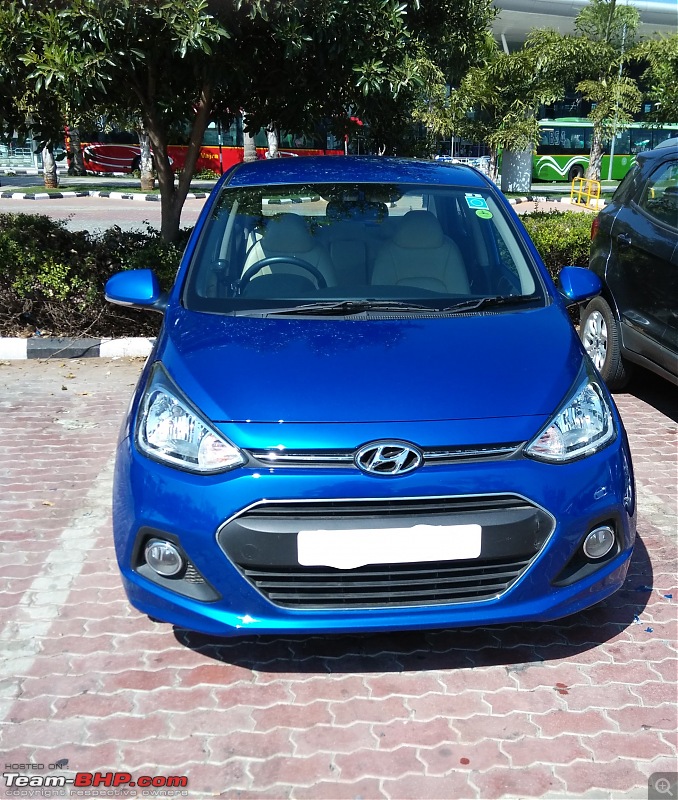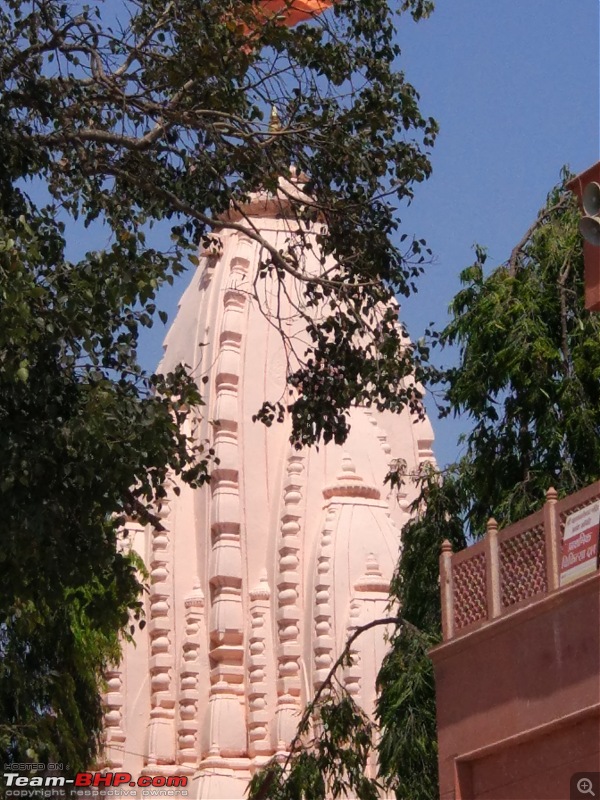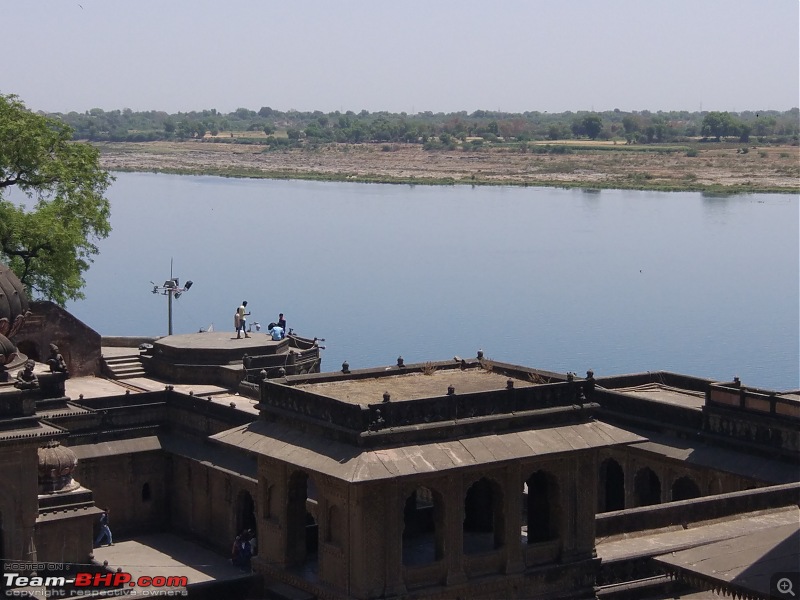| |||||||
| Search Forums |
| Advanced Search |
| Go to Page... |
 |
| Search this Thread |  25,553 views |
| | #1 |
| BHPian Join Date: Mar 2014 Location: Bangalore
Posts: 287
Thanked: 2,567 Times
| Journey to the centre of India It seems to be getting increasingly popular to travel to Madhya Pradesh. I was motivated to do so after reading Senior BHPian sdp1975's brilliant travelogue http://www.team-bhp.com/forum/travel...a-pradesh.html from last year. And then there is Anshuman's piece from earlier this year and now saleem_k's nice trip to Pench. Well, GTO is not going to dock me an infraction for inflicting yet another travelogue on you, so here it is ! But a pause here. Reading Team-BHP posts can be injurious to your wealth ! The three aforesaid gentlemen have breathtaking photographs and surely must possess camera equipment weighing one ton and costing just a shade under a Ferrari. The temptation to do so likewise is immense. Yours truly, being considerably lighter in weight (let's say the pockets are not overburdened with a heavy wallet) successfully resisted this urge and went ahead armed with no more than a mobile phone. With a debatable justification that a finely crafted word is worth a thousand photographs (ha ha) , this travelogue is being hereby launched. Solo trip as usual. The ride is the same - the steed with the heart of a Hercules that went to the North East two years ago. Hyundai Xcent SX(O) AT. Easy peesy after the horrors of the North East roads. 6000 kms door to door. All in March. The itinerary was Day 1 - Chennai to Hyderabad Day 2 - Hyderabad Day 3 - Hyderabad to Chhindwara Day 4 - Chhindwara to Patalkot to Pench Day 5 - Pench Day 6 - Pench to Kanha Day 7 - Kanha Day 8 - Kanha to Bandhavgarh Day 9 - Bandhavgarh to Amarkantak & back Day 10 - Bandhavgarh Day 11 - Bandhavgarh to Khajuraho Day 12 - Khajuraho Day 13 - Khajuraho Day 14 - Khajuraho to Sanchi to Bhopal Day 15 - Bhopal to Bhimbetka to Bhopal Day 16 - Bhopal to Ujjain to Indore Day 17 - Indore to Omkareshwar to Maheshwar to Indore Day 18 - Indore to Aurangabad Day 19 - Aurangabad to Ajanta to Aurangabad Day 20 - Aurangabad to Ellora to Grishneshwar to Aurangabad Day 21 - Aurangabad to Hyderabad Day 22 - Hyderabad to Bangalore Instead of a chronological or a sequential write up, I am grouping the experience into three heads - the historical sites, the parks, and the temples and then concluding with some random stuff. Last edited by Secretariat : 10th April 2017 at 07:45. |
| |  (14)
Thanks (14)
Thanks
 |
| The following 14 BHPians Thank Secretariat for this useful post: | aabhimanyu04, dailydriver, dark.knight, Déesse, GTO, haria, mallumowgli, MDED, paragsachania, Payaniga, Sangre, sdp1975, snaseer, V.Narayan |
| |
| | #2 |
| BHPian Join Date: Mar 2014 Location: Bangalore
Posts: 287
Thanked: 2,567 Times
| The historical sites There is so much history to experience on this trip. Even after I skipped Orchha and Mandu , for after all, you can't go everywhere. Let's first go back 1000 years in time Khajuraho Almost every travelogue to the region has covered Khajuraho, rightfully, for it is truly a wonder. But let's get one thing out of the way. Khajuraho has got very little to do with the Kamasutra. Only a very small number of sculptures are ribald and they fit in a larger context of the cycle of man. So those interested in voyeurism have to go elsewhere although the guides and the books try their best to market that erroneously as the USP. The Khajuraho temples were built around 1000 AD by the Chandela kings who ruled Bundelkhand . About 85 temples were built it is believed ; only some 25 have survived. Those that have survived will leave any viewer breathless. The stone sculptures that adorn these temples are easily amongst the finest ever done in India, anytime in history, and possibly amongst the great works in the world. When the dynasty fell the temples were forgotten. Forests reclaimed the area and this was remote, thick jungle and not easy to reach. Successive invasions had their effect on the temples. Mahmud of Ghazni came this way but was repulsed (the magnificent Kandariya Mahadev temple was apparently built as a thanksgiving). Sikander Lodi was a prominent destroyer. But their remoteness and having been forgotten saved a few . Ibn Batuta came this way in the mid 1300s and found them abandoned with only a few yogis living there. They lay forgotten until the 1830s, when the British rediscovered them. Since then they have been excavated and preserved as a World Heritage Site. There are hundreds of much better pictures of Khajuraho on BHP. So why don't you savour a couple of odd ones. 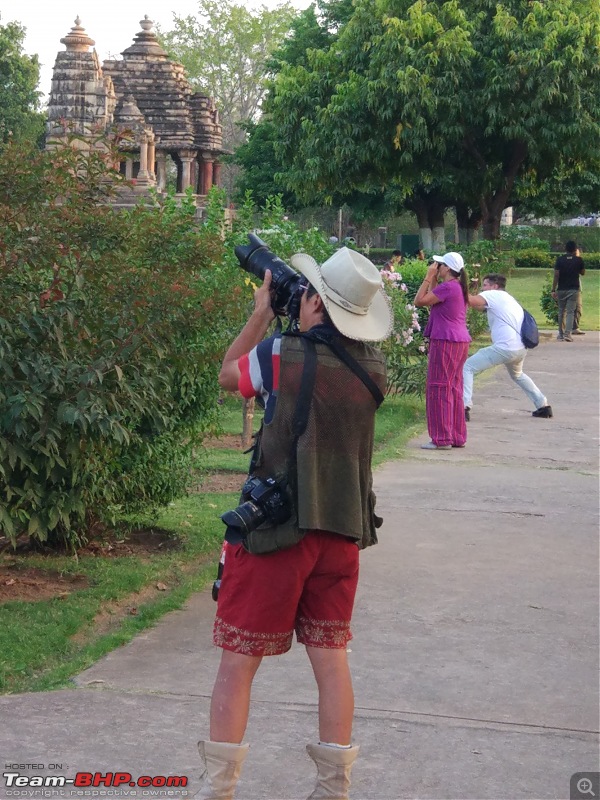 (He must be a BHPian judging by the number of cameras ; nice pose by the guy in the white T shirt !)  (Yes lots of foreigners here, but this is too much) I don't think the modern man of today is capable of such great works of art. What can we build today that we can confidently say will last a thousand years ? Have we lost the capacity to create such masterpieces ? Those that speak to us over the centuries ? How were they financed ? Will today's governments ever spend on something like this ? Our generation will probably see them as wasteful extravagance. But maybe, spending on immediate gratification and doling out money for today's luxuries is the actual extravagance. What do we leave for future generations to remember us by ? There is a sense of awe when you stand in front of great historical monuments. How did they create such exquisite sculpture ? What was the motivation ? How did the art pass from hand to hand through generations ? And how did they go into disuse ? What would the priest who did the last aarti have felt ? How must it have been when the temples were destroyed ? - those which had taken decades and unimaginable expertise and labour to build. Sanchi A further 1000 years back in time, to the reign of King Ashoka, about 2300 years ago. If you remember your history, he converted to Buddhism after the Kalinga war when he saw the misery and havoc that war created. He took to peace and for the rest of his life spread Buddhism in India and overseas, chiefly in what is now Sri Lanka. His wife Devi, was from Vidisha, a great seat of learning and an important town in those times. So near Vidisha, set on a hill in the village of Sanchi, he created a monastery . The monastery existed for a 1000 years before it fell into disuse and ruin. Again the time scales take your breath away - he created something that was functional for a 1000 years and still exists. Wow ! The Sanchi stupa is probably familiar to most Indians. It was partially destroyed and rebuilt often in both ancient and medieval times, but today it is in great condition. The monastery surrounding it is in complete ruin, but the columns holding the Ashoka pillar and the four lions, which are a feature of every Ashoka site, are still intact.  (Stupa No 1 at Sanchi)  (Intricately carved gates)  (The monastery is in ruins) 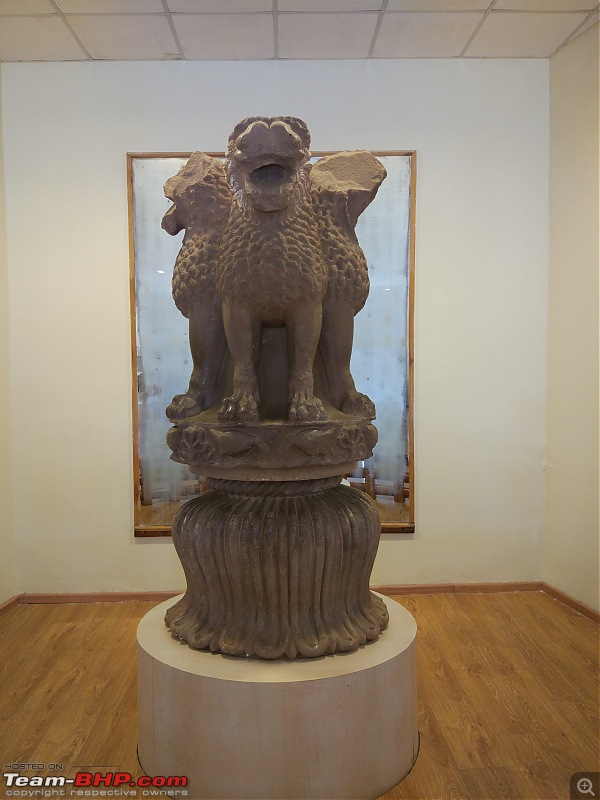 (The four lions at Sanchi; its now in the museum) Ashoka created many such sites. From the excavations, it is conjured that at Panguraria, in Sehore, not too far from here, there was an even bigger stupa than Sanchi. But that has been lost to history. Sanchi probably survived because Vidisha rapidly fell in importance and the site itself became covered in forests and therefore remained hidden. Sanchi fell into disuse and ruin around 1200 AD. It was then forgotten and lost to the forest until in the early 1800s it was rediscovered, by the British. But its real excavation happened around 1915. The then Director of the Archaeological Survey of India, Sir John Marshall is credited with the excavation and restoration of Sanchi. He stayed here for some 7 years supervising the work. In a lovely touch, the Archaeological Survey of India has created a small museum in the house that he lived in , as a tribute to him. Lovely touch that you would not normally associate with such bodies. Bhimbetka Humans have always been fascinated by their origins and early history. Homo Sapiens emerged in Africa about 200,000 years ago. But there is very little evidence of human activity until about 50,000 years ago when the first art, stone tools and other artifacts have been excavated. From then on, archaeological findings have been made on every continent. In India, one of the earliest evidence of human settlements are to be found in the rock shelters of Bhimbetka. Bhimbetka is very near Bhopal on the road to Hoshangabad. There are large rock formations in this general area and in many of the rock overhangs (some 250 of them) , we can see sketchings and art . Carbon dating has established that the oldest of them are between 10,000 and 30,000 years old. These are the first evidence of stone age in India. This is now a World Heritage Site The drawings depict some of the common themes of that time. The people were hunter gatherers (agriculture had not yet been invented then). They must have lived in the caves for safety and their habitat was heavily forested with an army of animals for company. The art shows hunting, shows the animals of that time, dancing and some other aspects of their daily life. The colours used are from vegetable dyes and it completely flummoxes me that they are still very clear after at least 10,000 years despite being open to nature. They have been drawn on rock overhangs, sometimes very high up indicating that they must have had some platforms made to do that.  (Such vivid colours after 10,000 years)  (Going to fight, maybe; or to hunt) 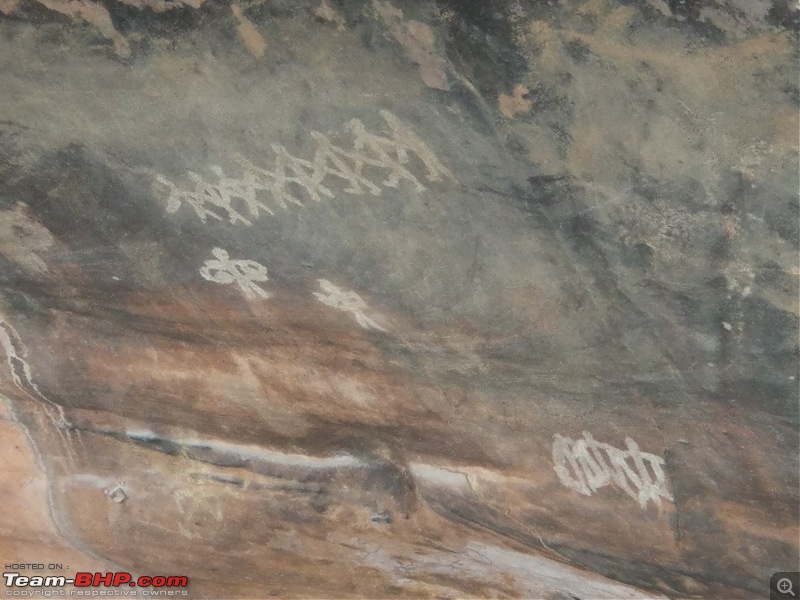 (The world's first dance party ? there's even a guy with a drum) The rock shelters of Bhimbetka were discovered only in 1957 by the famous archeologist , Padma Shree Dr Wakankar from Ujjain. He is also credited with the discovery of the river basin of the mythical Saraswathi. I was delighted that, for once, it was not the British who rediscovered our heritage. The joy of expression seems to be a fundamental human trait. Why else would ancient humans have thought it fit to draw or sketch what we now see at Bhimbetka. What would they think if they knew that descendants would gaze at their work 10,000 years later. And how on earth did those dyes survive so vividly for that long . Fascinating to dream of how life would have been at that time. This is the longest you can go back in history in India. Come here if you can ; its only an hour's drive from Bhopal. Ajanta & Ellora OK, this isn't in Madhya Pradesh, but then this is a journey to the centre of India and if you sort of look at the India map with a squint, this isn't far off from the centre ! Once in a while, just once in a while, everyone is allowed to do something very touristy. The Ajanta & Ellora caves have probably been visited by every BHPian. It has been a very popular tourist destination for decades. I hadn't ever been there, and as this was on my route, I took a couple of days to join the hordes of Indians who have been to Ajanta (or Ajintta as it should be rightfully called in Marathi) and Ellora. Ajanta is as awesome as it is made out to be. For those unfamiliar with Ajanta, it is a set of some 30 caves carved in a rock cliff and which served as Buddhist monasteries and temples for a long period. The earliest caves are from the 2nd century BC and range until the 6th century AD. There must have been exquisite paintings in the caves. Much of it has been lost, but what remains is enough indication of how grand it must have been. There are also sculpted works and lots of images of the Buddha. I can imagine the monks at their morning prayers, hymns being chanted, workmen probably working on the next cave, maybe a new monk arriving to take his vows, probably an older and wiser monk training the newly initiated.  (The Ajanta Caves) 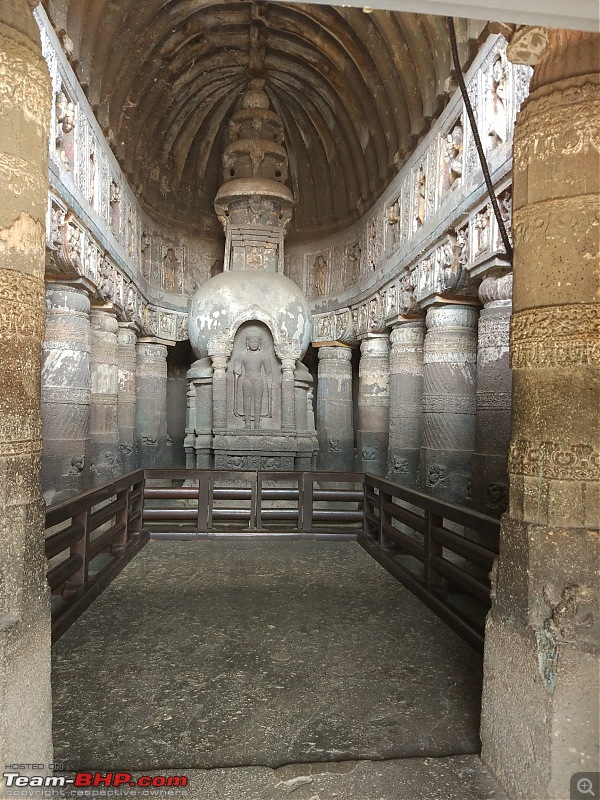 (A grand cave)  (Lovely sculpting)  (Alas, lots of it is lost ; what might have been) 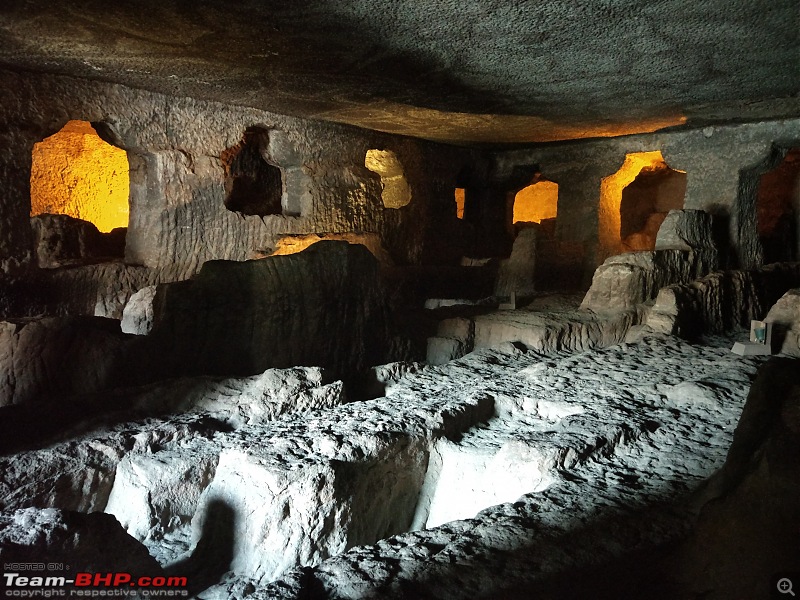 (An unfinished cave) Ellora was done a bit later in time, between the 6th and 11th centuries and covers three religions, Buddhism first, Hindu next and Jainism third. Who cannot, but marvel at the incredible Kailash temple, arguably the largest monolithic structure in the world and which was carved from a single rock, top down.  (The largest at Ellora; probably served as an auditorium)  (Looks like a hostel; that's probably what it was) 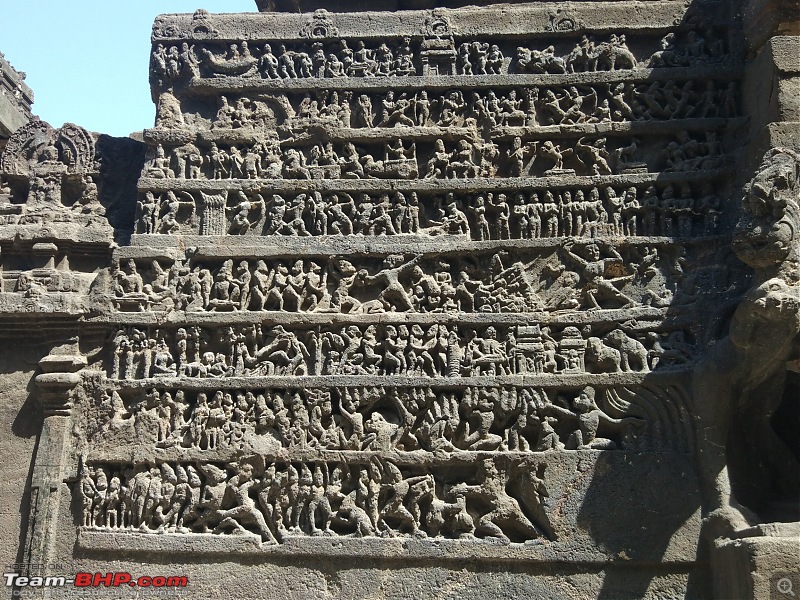 (Beautiful sculptures at the Kailash temple)  (a lovely Jain temple) As in every historical site I have visited on this trip, I am having so many questions. How did the sculptors and painters work in a pitch dark cave - there's no evidence of fire blackening anything. So, how did they do it ? (Yeah, the guides spin some theories, but do we really know ?). How did they even approach this place ? These are caves on a sheer rock face. Today there are roads and paths, but then ? What about food ? Buddhist monks traditionally are frugal, but they still had to eat. How did they grow anything on rocks ? It's a torturous route to the plains; is that how the food came ? Who protected them from the inevitable wars and the armies ? The caves were mentioned in historical records till medieval times and then seem to have been forgotten. Nature reclaimed them and once again in the 19th century they were rediscovered by, who else, the British. They seem to have escaped the destruction of the Muslim rulers ; probably because they were forgotten and remote. I wish there was a way to peep back in time. Not time travel, but simply have a magic mirror through which you could see what happened in those times. I cannot imagine anything that would be more fascinating. The tomb of Aurangzeb 14 rupees and 12 annas. That's what it cost to build the tomb of Aurangzeb. After the lavishness of Humayun's tomb at Delhi, Shah Jahan's at the Taj and Akbar's at Sikandra, came the piety of Aurangzeb. Aurangzeb, the sixth and really the last of the great Mughal emperors, died in the Deccan and as per his wishes he was buried in Khuldabad, near Ellora in a simple grave with no grand tomb constructed. The grave was paid for from the earnings he personally made tailoring caps and not from the royal treasury. Aurangzeb is an extremely controversial figure. He was pious and simple, but was also responsible for innumerable wars, the destruction of many Hindu temples and much cruelty. Whatever you may think of him, it cannot be disputed that he is a huge historical figure. He could have built a lavish tomb and today a few million people would visit every year, as they do at the Taj. He would have been famous around the world to this day. But he didn't. That counts for something. Last edited by Secretariat : 9th April 2017 at 22:11. |
| |  (17)
Thanks (17)
Thanks
 |
| The following 17 BHPians Thank Secretariat for this useful post: | aabhimanyu04, aargee, dailydriver, dark.knight, GTO, haria, khoj, Mahesh Prasad, mallumowgli, MDED, paragsachania, sdp1975, shobhit.shri, SmartCat, V.Narayan, vinit.merchant, Vitalstatistiks |
| | #3 |
| BHPian Join Date: Mar 2014 Location: Bangalore
Posts: 287
Thanked: 2,567 Times
| The Parks This is not the first travelogue describing a visit to the great forest reserves of Madhya Pradesh and it won't be the last. Many a BHPian will come this way . I'll cover this with the full knowledge that a Mi5 should not even be mentioned in the same sentence as a Phantom v1610 (of the 1 million frames per second fame and presumably the toy of sdp1975, Anshuman, saleem_K at al !!) . It must also be disclosed that I cannot even spell the Little Scalybellied Green Woodpacker, let alone spot it. In search of Mowgli at Pench Kipling's famous Jungle Book, written as a collection of tales in 1894, and then made in to a movie, was set in the Seonee jungles. That is now the Pench National Park. Kipling himself never visited Seonee and very possibly borrowed liberally from Robert Sterndale's books. But who cares ? This is Mowgli land. Pench is a lovely forest reserve. 60% of the trees are teak. Imagine the wealth lying here, of course only on paper as the Forest Dept ensures that you can’t even take out a twig. It is bone dry now and therefore the forest is an ocean of barren tree trunks. Makes sightings easy , which is why this is the fag end of the visiting season before it becomes too hot. The game drive itself is usually on a 6 seater Maruti Gypsy designed for 6 inch long legs. If yours are a few feet long (pun intended) like mine, you essentially sit curled up like a ball for three hours where you even forget that you are cramping like crazy. Off you go in a cloud of dust – the tourists are all clad in their latest sun gear, fancy caps they have purchased in their souvenir shop and wearing baggy shorts – none of which is sensible at all. You really ought to cover your arms and legs and wear a purdah. Everybody goes to see the tiger and counts the safari successful only if they have seen one. I don’t mind not seeing a tiger at all. The wonderful atmosphere, the sounds of the forest, the stillness in the air, the anticipation of seeing something, are all priceless. No predators were anywhere around today – the Bandar-Log (monkeys) were playing around on the ground, the deer weren’t bothered, Mao (peacock) strutted up and down and a pair of Tabaquis (jackals) calmly walked ahead of us on the trail. Kaa the snake lay quietly under a tree stump. Bageera had taken Mowgli far far away and Baloo was hibernating. Shere Khan was nowhere to be seen. The atmosphere was all peaceful. No danger call from the sambhar; no sudden tension in the air.  (Pench is now dry and bare)  (Two friends at peace) 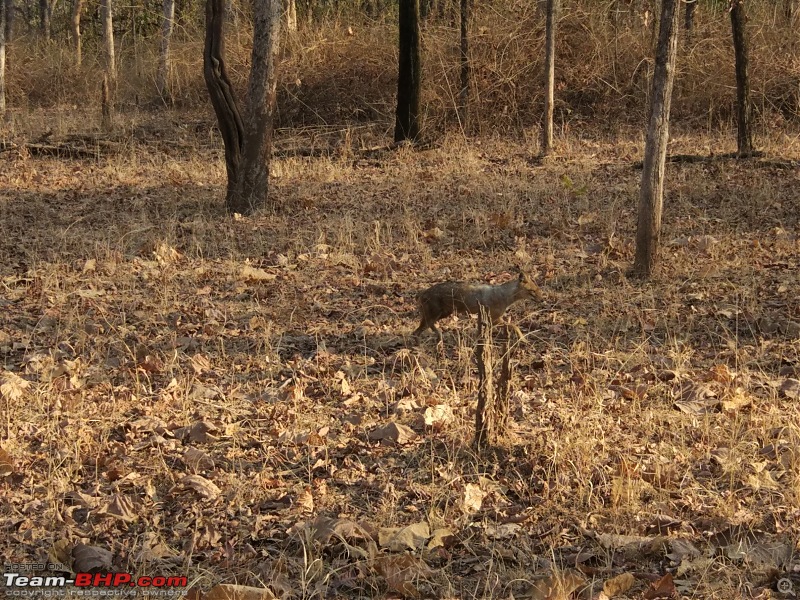 (Mrs Jackal says Hi)  (Spot the deer's backside- what photography skills!) You see, this was the Holi weekend. Uncles and aunties, complete with Gullu, Tinku and Mummyji have descended in hordes and are making an absolute racket. Shere Khan has, no doubt, run a 100 miles away - no hunter is a match for an aunty in full flow. I simply plugged my ears and went off to sleep, hoping that they would all disappear with the Holi weekend. Walking at Kanha At the crack of dawn, I set off. It’s really chilly in the morning. Not bitingly cold as it would be in January, but still cold enough to need woolens. A hot cup of masala chai to warm the insides and I set off with my guide on a walking safari. Kanha is one of the few places where you can both do a walking safari and a night safari. Kanha like all reserves is divided into a core zone and a buffer zone with a natural demarcation of the river. The core zone is only for vehicle safaris. The large buffer has a walking trail and the forest dept allows a very small number of people to walk , accompanied by a guide. Animals move freely between the zones. I walked alone accompanied by only the guide for some 10 kms. This is the way to experience a forest. The sights and sounds, undisturbed by the sound of vehicles, is really something . You may not see many animals, or any at all, simply because you can cover only a small area on foot. But even if you don’t see a single animal, it’s an outstanding experience. Sighting animals is pure luck. My guide told me of an experience when he was taking a couple of college students on the same trail in January. They were walking quietly and simply stumbled upon a tiger sitting right next to the trail. On foot and a tiger at 100 feet. Wow !! I had no such luck. The trees in Kanha are mostly sal, unlike Pench where its mostly teak. More green here. Being a huge park, there’s enough habitat for many tigers and there’s abundant prey. It’s also the only home of the hard ground Barasingha , the huge swamp deer. Stories and stories abound of the legendary tigers of Kanha of the past. Just like The Maneaters of Kumaon, the famous book by Jim Corbett of the park which now bears his name, there are similar books on Kanha as well. It really is a beautiful forest reserve.  (Kanha is greener)  (Set off on the trail)  (Mist rising from the pond)  (Beautiful vistas)  (This is from where BHP travelogues ought to be written ! ) We walked and walked. The coucal kept haw haw hawing in volumes completely disproportionate to its size. A few monkey alarm calls were heard, but they were far away. This being dry season, it’s possible to get into the river and hop on to the rocks. We sat on a pile of rocks in the middle of the river and had a leisurely breakfast as the sun rose. Absolute bliss. Then we turned and walked back. The tiger, at last, at Bandhavgarh Landed in Bandhavgarh into an absolute gem of a place. Massive cottages , each completely secluded and with a huge glass wall leading to a magnificent view of the forest. You go to sleep and wake up to picture postcard views . It almost feels as if you are sleeping in the open . The place is inside the core forest reserve and is in the territory of Bhim, apparently the largest tiger of all in India. His cave where he spends the hot day sleeping, is 500 mtrs from this place. Every evening and morning as he commutes to and fro his “work” there are alarm calls and he roars to make sure everybody knows he is the king. There’s no better appetizer for dinner than the symphony of a tiger roaring. There are a few staying here who are scared to go to bed after hearing Bhim ! They are very impressed with me staying alone in a secluded room. There’s the usual “tribal” dance which is standard fare at these places, and which invariably ends with obese guests making a fool of themselves trying to join in. Usually I give these a wide miss. However, I stayed on for this. This was a dance that they actually do often in real life. There are quite a few villages inside the forest and sometimes a tiger takes up residence right next to or even in the village. He has to be driven off or else a tragedy is bound to occur Apparently the forest guards call these tribals to shoo the tiger away, They do this by forming a human wall and to the loud beating of drums and music advance to the tiger. They refuse to stop as the tiger roars and threatens and it always ends with the tiger being driven off – unharmed but with a distinct dislike for tribal music. They performed this yesterday and it was interesting to watch. I am not sure what Bhim, who wasn’t far away, thought of this. Clad in multiple layers, for it's still chill early in the mornings, I set out next day. Within 10 minutes, and even before we had entered the trail proper, there they were. Three tigers, a mother and two one year olds , right by the road. They wanted to cross the road and go to the other side of the forest, when they were confronted with a mob of tiger seekers, yours truly included. For 15 minutes the drama played out as the tigers found crossing this lonely jungle road as hazardous as crossing the ORR at Marathahalli . Calmly they did, after a few irritated growls and I have little doubt that about 10 million photos were clicked in those 15 minutes. Finally they crossed and vanished into the deeper jungle.  (Mr Tiger approaches the Marathahalli crossing)  (And faces the full brunt of Bangalore traffic)  (A majestic pose)  (Because of the bamboo, Bandhavgarh is the densest of all) 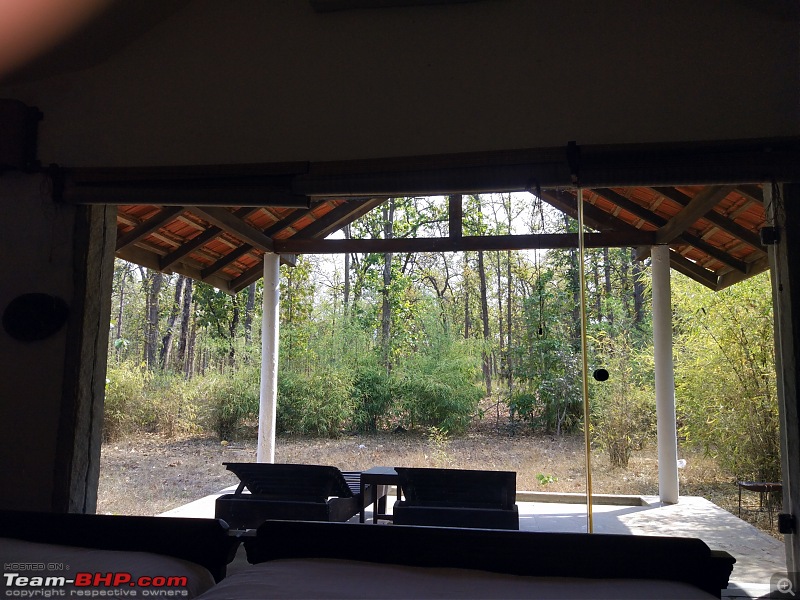 (With a view like that from my bed, what is the incentive to get up) We got on to the main safari and saw little for the next 4 hours, As a co passenger, you fear the most, two specimens commonly found on safaris - the loud auntie with her Bablu or the fanatic bird photographer. I unfortunately got the latter in my vehicle. Armed with a camera which, I swear, measured 3 feet in length, he set about trying to "bag" the most teeny weeny bird that I could not even see. So we played out the same routine again and again- STOPPPPPP, go forward 6 inches, go backward 3 inches, photographer contorting in impossible positions, long peer through the lens, click , click, click, more contortions, more peering, click click click, repeat this 7 times, and the rest of us wondering what are we missing. Then comes the proud announcement -I have got the Little Scalybellied Green Woodpacker " ! And we all had to say Wow ! I was scared that I was poking fun at a fellow BHPian, but since there is no travelogue on the same precise dates, I think I am safe. Last edited by Secretariat : 9th April 2017 at 22:19. |
| |  (20)
Thanks (20)
Thanks
 |
| The following 20 BHPians Thank Secretariat for this useful post: | aabhimanyu04, aargee, abhishek46, amit1agrawal, amitkb, anand.shankar, dailydriver, dark.knight, GTO, haria, Mahesh Prasad, mallumowgli, MDED, paragsachania, saleem_k, Sangre, sdp1975, shobhit.shri, SmartCat, V.Narayan |
| | #4 |
| BHPian Join Date: Mar 2014 Location: Bangalore
Posts: 287
Thanked: 2,567 Times
| The temples This BHPian freely admits to having committed many a sin. Since he is currently in that phase of life where he is considerably advancing the average age of Team-BHP, he has turned his thoughts to achieving some salvation, however futile the attempt might be. Therefore many a temple was visited, many a prayer was made and honestly many a thanks was given at being able to do this drive safely and without incident. The birth of the Narmada at Amarkantak Amarkantak is a lovely lovely place. Its not easy to reach and hence there are no crowds. I am sure on big festival days, it would be packed, but not when I was there. Peaceful, serene amidst a lovely setting. and with a beautiful quiet temple. Goddess Narmada is worshipped, and interestingly the temple also has sanctums to Rama, and there is a Shivling. Clean, no crowds, nobody harassing you for money – it was tranquil. I simply stayed there for a while in quiet contemplation. Near the temple, which seems to be a couple of hundred years old, there’s the older temple complex , said to have been established by Adi Sankara in the 8th century. He also marked the origins of the Narmada with a “Kund” which is still there. Now its not a functioning temple but the Archeological Society of India has preserved it immaculately as a historical monument. Does it really matter whether a temple is functional or not ? I felt the same peace and tranquility here as in the main temple.  (The Narmada temple at Amarkantak)  (The sacred Kund)  (Quietly begins this majestic river)  (The old temple from Adi Sankara days) The town itself is small and nice. None of the usual chaos of temple towns. There’s a gurudwara, a Jain temple and a few ashrams that look gorgeous. The river itself flows down from the hills here through the plains of India and ends up in Gujarat and the Arabian Sea. It's one of India’s great rivers and has nurtured millions of people through the ages – a true life giver to the heart of India. On this trip, I crossed it many times, but I was glad that I was able to make it to its birthplace. It's a very special place. Mahakaleshwar Mahakaleshwar, at Ujjain, is one of the twelve Jyothirlings. It is a must visit place if you are religiously inclined; if not, it is a must miss ! I was sceptical about what to expect having had mixed experiences in the four Jyotirlings I have so far visited - wonderful experiences in Somnath and Rameshwaram and not so good experiences at Kashi and Dwaraka It was a very moving experience this time. The crowds were low and there wasn't much of a waiting time. The temple was clean and nobody harassed me for money. And at the sanctum, there is nobody hurrying you to move on. They have constructed a tiered viewing gallery and you can go up the tier, sit there in peace for as long as you want, while having darshan. There is largely silence other than chants occasionally raised by the devotees. I went up and sat quietly for half an hour. It was sublime. There are numerous shrines in the complex including one to Mahakali - its a Shakti sthal as well and its believed the upper lip of Sati fell here. In all the shrines, there is peace. Many people try and make it to the "Basma Aarthi" which is held everyday at 3.00 AM in the morning, but you have to queue up for tickets on the previous day and it's a lottery, so I did not even try for it. The site itself is a very ancient site and of prehistoric origins, the first textual evidence for the temple coming from the 6th century BC. However most North Indian temples were destroyed by the rulers of medieval times - this one suffered at the hands of Iltutmish in 1234 when he sacked Ujjain. The current temple is an unimpressive architectural edifice and of 19th century origin. So the awe of the temple was not there. But when you are in the sanctum, you don't see the building, you only feel the Lord. Omkareshwar This was a Jyotirling I had looked forward to going to. On the banks of the Narmada, there are actually two temples ( both are considered Jyotirling together). Mamleshwar on the south bank of the Narmada and Omkareshwar on an island in the river. The island is said to resemble the letter Om and hence the name Omkareshwar (Lord of the Om sound).The banks of the Narmada has to be a picturesque and peaceful setting for any temple. It's a two hour drive from Indore dodging lumbering trucks and kamikaze taxi drivers on a good but narrow road. My track record of alternate good and bad experiences at Jyotirlings continues. Mahakaleswar at Ujjain was wonderful. Omkareshwar, alas, was not so. There were no crowds at all and yet the experience wasn't great. The sanctum itself in Omkareshwar is in a very narrow room and was chaotic with pushing and shoving even though there was no crowd The temple premises didn't inspire awe. I quickly came out. Mamleshwar was better, but even there the ling is very small, hardly visible and in a small place. The premises have a more "temple feel", but even here I just didn't feel a connect. I left. I shudder to think how this place would be on Maha Sivarathri day. From Mamleshwar you can either take a boat or walk on two pretty bridges to reach the island of Omkareshwar. I wonder how the boatmen ever allowed the bridges to be built (they are the first to oppose any bridges anywhere saying their livelihood is at stake and then proceed merrily to fleece the traveller). Here the methodology is to lure the devotee into doing a boat parikrama of the island and charging four figures for it. The priests not to be outdone display divine abilities in doing business, although they pale into comparison before the true masters who are at Puri. At least for me, the experience of a temple is a function of state of mind. I crave silence, respect, humility and cleanliness to feel a divine connect. If its not there, I am not yet evolved to transcend them. Great souls have. For lesser mortals like me, its a big challenge. I am afraid this was just a tick mark. I moved on. Grishneshwar Grishneshwar or "The Lord of Compassion" is the smallest of the Jyotirling temples. As with most other temples it was destroyed by invaders and rebuilt on more than one occasion. The current temple was rebuilt by Ahilyabai Holkar - another reason to respect this impressive queen. The temple itself is more in the South Indian style - an elaborately carved gopuram and sub shrines around the main shrine very typical of South Indian temples. The sanctum and the ling are small and the practice inside the shrine is more North Indian - you can enter inside, touch the idol, perform abhishek yourself etc But in a more Keralite fashion, men have to take their shirts off to enter the sanctum, although they can keep it on if they are just doing a darshan and not entering inside the sanctum. The temple thus seems to be a blend of North and South Indian practices. In keeping with my alternating experiences at Jyotirlings, this one was wonderful. The small temple lends a neighbourhood temple feel. There were absolutely no crowds. I went a bit early and at that time, I was for periods, the only devotee. A few came and went but nobody stayed. I went inside the sanctum and simply stood in silence and prayer for a while. Nobody shooed me away or asked for anything. It was easily one of the most peaceful temple visits ever possible. No cameras inside the temple, as is currently the norm everywhere. Security was lax as there really wasn't anybody around, but I , of course, obeyed and kept my phone in the car. In this temple, it would have been a sacrilege to take photos. It was a special experience that cannot be captured in images or words. It simply has to be felt. Last edited by Secretariat : 9th April 2017 at 22:27. |
| |  (13)
Thanks (13)
Thanks
 |
| The following 13 BHPians Thank Secretariat for this useful post: | aargee, dailydriver, dark.knight, GTO, haria, jphukan, khoj, mallumowgli, MDED, mpksuhas, paragsachania, sdp1975, V.Narayan |
| | #5 |
| BHPian Join Date: Mar 2014 Location: Bangalore
Posts: 287
Thanked: 2,567 Times
| MP is just not history, parks and temples There's more to the heart of India than history, parks and temples. How about this gem of a place very few people know about or go to. Patalkot As Patalkot (pronounce it as Paataalkot and you'll get it) is at the foot of a deep ridge, it actually wasn't "discovered" until a few decades back. The dozen odd hamlets lived an existence cut off from the rest of India for centuries. Sunlight comes late and leaves early because of the steep cliffs. Just about 2000 odd tribals (Gonds and Bharias) live here. It has a unique ecosystem of rare medicinal plants and herbs not found elsewhere in India and the tribals are skilled at utilising these to make medicines that reputedly cure a whole host of illnesses. Legend has it that Meghnath, the son of Ravana passed this way to the netherworld. Legends, true or not, are useful in creating an aura for the place. With the valley now open, there is danger of commercialisation and the destruction of the medicinal plants. The government is trying to promote eco tourism and there are strict warnings against any destruction, or even plucking of plants. Thankfully, as it is fairly remote, the hordes of tourists are still not coming.  (Patalkot from the top) 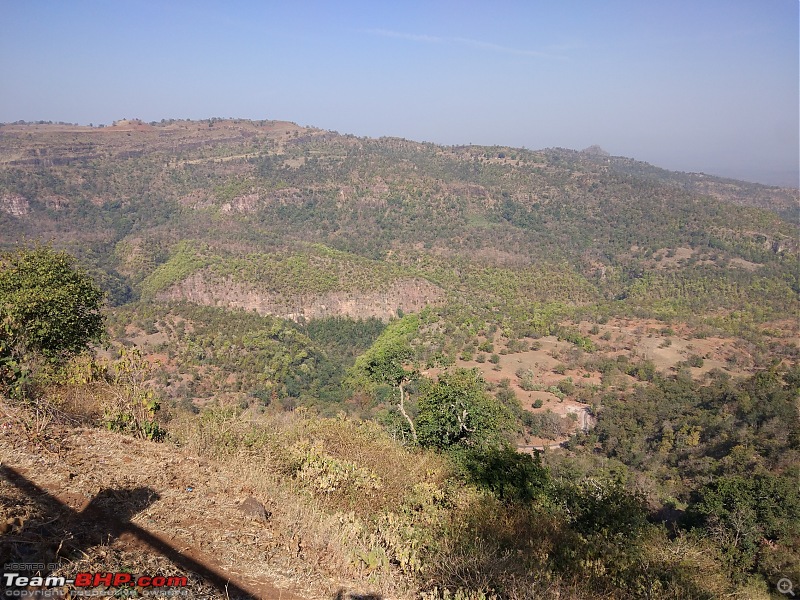 (Absolute desolation) 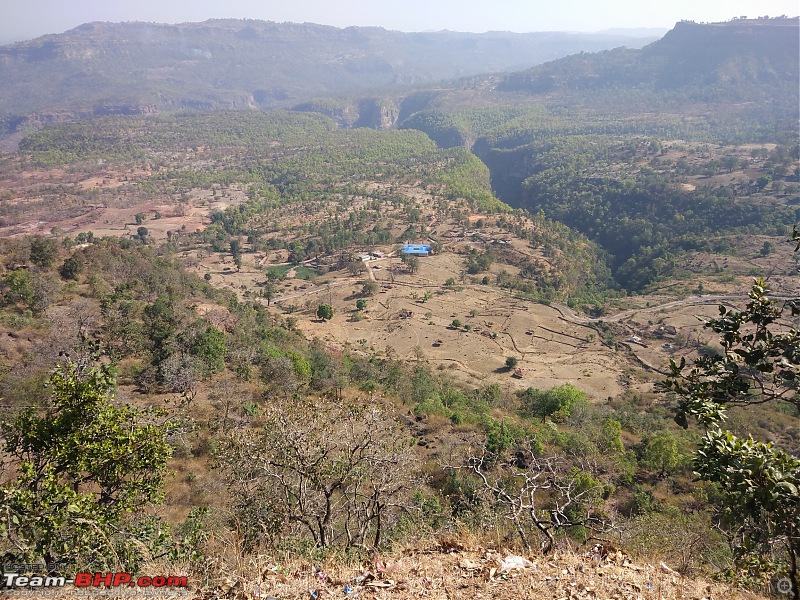 (The ridge) 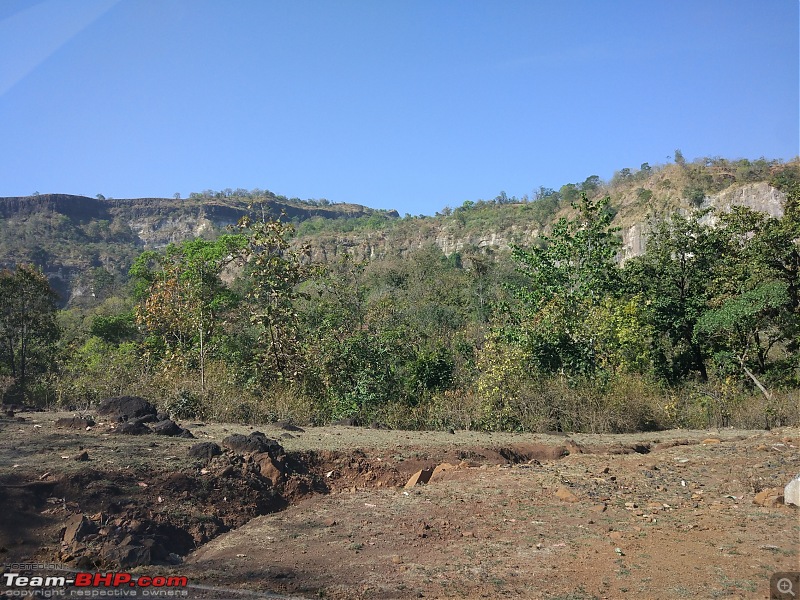 (Now at the bottom) 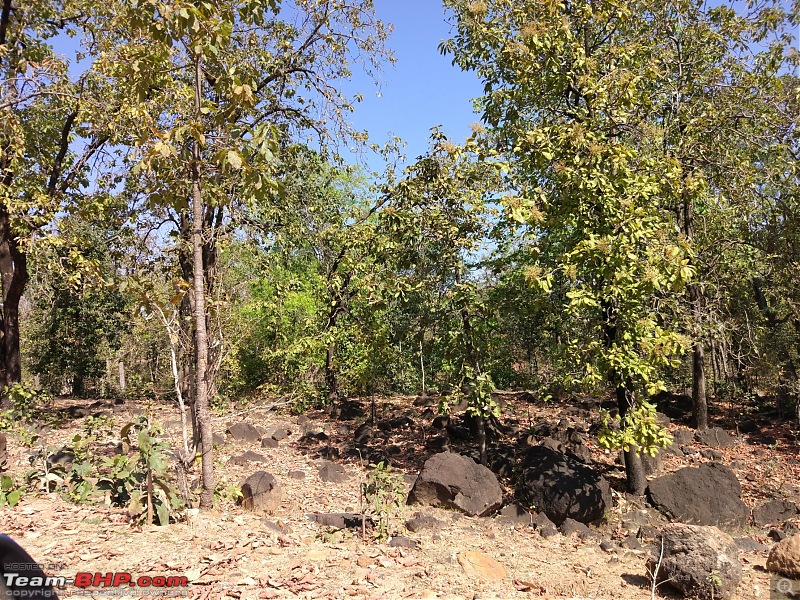 (Medicinal plants and trees galore)  (Gives an idea of the steepness of the slope) I drove to the edge of the cliff and looked at Patalkot way down below. Beautiful views. Once I had the view from the top, I of course had to go to the bottom. Thankfully, there is now a road and off I went. The place is desolate. I was the only outsider there. I listened to the stillness. I simply got down from the car and sat still for a while. Passed a couple of hamlets, and is the wont in rural India, everybody, including the women, stared openly at this strange being . Didn't stop to chat, unlike what I would usually do, simply because I was savouring the stillness and the silence. Hell ain't that bad, eh !! It was then time to go back. I climbed back up the ridge on the road and then wended my way back to "civilisation".* As is well known, its often easier to go to hell than to go to heaven. I can now claim to have to gone to the edge of the underworld and turned back !! An honourable queen Yes, this is history, but she is very special and deserves more than just a footnote in history. There have been a few queens in Indian history, who have been famous in their own right and have ruled with much accomplishment. Razia Sultana and Rani Laxmibhai of Jhansi will probably come to every Indian's mind. Amongst the pantheon of the great rulers of kingdoms in India, must surely feature Ahilyabai Holkar who ruled the Malwa kingdom in the second half of the 18th century. Ahilyabai was married to the son of the Malwa king and when her husband died in battle, she prepared to commit sati as was the custom of that time. Her father in law forbade her and said her wisdom and stewardship was crucial for the kingdom. Saved from the funeral pyre, she became the Queen in 1755 and ruled as a just and wise ruler for nearly 30 years. She resisted the Muslim invaders that were the scourge of every kingdom at that time, personally going to battle. But her legacy is really the wisdom of her rule. She was fair and just. She patronised the arts. She restored temples and built dharamshalas across India and well outside the boundaries of her kingdom - Kashi, Somnath, Gaya, Kanchi , Ayodhya, Mathura; literally everywhere. Go to any place of importance to Hindus across the country and you are likely to see her imprint. It was she who built Indore from a small village to a prosperous city that it is today. She was such a benevolent ruler that people virtually sainted her after her death. Her capital where she ruled from was Maheshwar, on the banks of the Narmada. Her house (no ornate palaces for the Holkars) and fort are maintained nicely even today and that is where I went to commune with one of the respected figures in Indian history. I am delighted to say that there were lots of visitors, common folk from the state. She is widely respected in this part of the country even today. It was a nice peaceful visit. Topped up by a lunch sitting besides the river in a neat little restaurant there. You see, how many people in the world can claim such an eulogy - for this poem was written in her honour by an Englishwoman some 50 years after her death. "For thirty years her reign of peace, The land in blessing did increase; And she was blessed by every tongue, By stern and gentle, old and young. Yea, even the children at their mothers feet Are taught such homely rhyming to repeat "In latter days from Brahma came, To rule our land, a noble Dame, Kind was her heart, and bright her fame, And Ahilya was her honoured name." The street food capital of the country Full disclosure. I am not a foodie. I am happy to exist with nothing but Soylent, if that were possible. So, what am I doing writing about food. Well, if you go to the street food capital of the country, you can't avoid at least seeing the food, can you ? There are two of them , food streets that is, in Indore. The first is Chappan Dukaan or 56 shops. There aren't that many now, but once there were. This opens for breakfast and lasts through dinner. This is very "posh" compared to the other one - lots of namkeens on offer, golgappas slurped by the million, kachoris, chaats and grrrrrr "Johny Hot Dog" (whatever that is). But the real terror is Sarafa. This is in the old city of Indore and is a cramped street full of jewellery shops. When they close for the night is when the food action starts. Hawkers of all varieties, shapes and sizes set up their stalls on this street, starting from 8.00 or 9.00 PM and go on till God knows when. The street is cramped and is supposed to be pedestrian only, but of course the two wheelers are whizzing by. And there's all sorts of stuff being sold. Smartly dressed Indoreis are gorging themselves - the place was packed when I went. Smartly dressed teens and twenty somethings are mixing it up with venerable fossils. Apparently its all very tasty - what you might see as unhygienic, is actually an addition to the flavour ! A gargantuan quantity of food is being consumed. No; I didn't eat any of this stuff ! Last edited by Secretariat : 9th April 2017 at 22:38. |
| |  (19)
Thanks (19)
Thanks
 |
| The following 19 BHPians Thank Secretariat for this useful post: | aabhimanyu04, aargee, amit1agrawal, anand.shankar, CliffHanger, dailydriver, dark.knight, GTO, haria, InControl, jphukan, MDED, mpksuhas, paragsachania, saleem_k, sdp1975, shobhit.shri, SmartCat, V.Narayan |
| | #6 |
| BHPian Join Date: Mar 2014 Location: Bangalore
Posts: 287
Thanked: 2,567 Times
| Another trip comes to an end Summer has set in all over India. In the heart of the country, it's 40 deg C in the shade. Even the nights are hot and sultry. Any sane man would retreat into his cave , pun intended with all the caves I have been visiting. The visit to Grishneshwar was so fulfilling that I returned for the night aarti. Again there were no crowds ; there were hardly 15-20 people. We sat in the courtyard as the priests cleaned the ling of all the flowers and offerings, and did a simple decoration. The aarti was soulful. Not too loud, not too showy, but intense in devotion. I stood in silent thanksgiving. For all the good fortune I have had and continue to have, rather than all the difficulties. This trip itself has been quite fulfilling. As in my earlier road trips, luck has been my way. I have had no setbacks, no disruptions, no unpleasant experiences. And I have accumulated another trunk load of memories that will stay. For sure, they will fade over time, but perhaps this travelogue would rekindle them in the future. I reflected on my experience visiting the heart of India, mostly Madhya Pradesh. It's a nice state, with lots to see although its not prime on the tourist trails. The roads in general are pretty good. Except for the stretch around Pench, the approach to Mandla and the stretch between Satna and Khajuraho, there weren't any bad roads on my trip. Even these were not too bad. Maybe I am hardened by being a Bangalorean and by the terrible roads I have seen in the North East. Roads in general are pretty good. What was not so good was the chanda extortion around Holi. I had no idea that this extends for 5 days in MP. Children, women, young, old and every form of human being at every village wanted chanda. Is this what we have become as a country - extort if you can. I refused to pay anywhere preferring to yell and argue rather than pay. I was of course cursed roundly and every disaster was wished upon me. The only saving grace was that the trucks had all disappeared knowing this and I had a clear road. Driving in Bhopal was a revelation. I was there only for two days and obviously rode on only a sample of the roads. But nowhere in India have I seen such a blatant disregard for a red light. Nobody, and I mean nobody, ever stopped for a red light. I was a strange creature stopping for every one of them and have been subject to the choicest and most colourful gaalis that I have ever heard. Even I had to jump a red light once as a LCV was bearing on me thunderously and if I had stopped, I would surely have been rear ended. What is this with Bhopal ? Back at Grishneshwar. I also stood in silence for what the future might bring. There can only be a finite set of travels possible. It is unlikely that I will come this way again; certainly not in this manner. And as is often said, you never travel the same road twice, for, even if the road is the same, you are different. No doubt generations of BHPians will come this way and a few might write about it, in which case I can give an indulgent smile. The aarti finished and we were offered the opportunity to take blessings from the flame. I did so with a prayer for all of us. For all BHPians who travel by road, for we need both luck and some divine help to have enjoyable journeys. The crowd melted away. I was alone. A sigh escaped; a mixture of joy, peace and thanks. And then I turned around. It was time to go back. Three weeks and 6000 kms later, I was back home in Bangalore. Thank you for reading this travelogue . Wishing you a safe journey whichever direction you are heading. Last edited by Secretariat : 9th April 2017 at 22:40. |
| |  (31)
Thanks (31)
Thanks
 |
| The following 31 BHPians Thank Secretariat for this useful post: | aargee, aithalsandy, alphadog, amit1agrawal, amitkb, arvind71181, BUXX, CliffHanger, dailydriver, dark.knight, Déesse, GTO, haria, InControl, jphukan, khoj, KLxpress, mallumowgli, paragsachania, revvenant, rosaf, Sangre, sdp1975, Shreyans_Jain, Simhi, SmartCat, V.Narayan, VaibhaoT, vivekkp, zavegur, Zinda |
| | #7 |
| Team-BHP Support  | Re: Journey to the centre of India Thread moved from the Assembly Line to the Travelogues section. Thanks for sharing! |
| |  (1)
Thanks (1)
Thanks
 |
| The following BHPian Thanks Aditya for this useful post: | GTO |
| | #8 |
| BHPian Join Date: Jan 2017 Location: Hyderabad
Posts: 96
Thanked: 87 Times
| Re: Journey to the centre of India Very sweet travelogue. Thank you for all the insights into the religious places. I am very much tempted to retrace your steps this monsoon. |
| |  (1)
Thanks (1)
Thanks
 |
| The following BHPian Thanks revvenant for this useful post: | Secretariat |
| | #9 |
| Senior - BHPian | Re: Journey to the centre of India Enjoyed reading the travelogue and loved the narration . Being on the roads for over 3 weeks is quite a lot ! Happy to see that my travelogue inspired someone to travel. I, in turn , was inspired by Fauji's excellent travelogue on MP. MP isn't very touristy yet , and has a rustic charm associated with it. I haven't covered several places that you did and another trip to MP is due. By the way , did you stay overnight at Amarkantak ? In which hotel if you did ? |
| |  (1)
Thanks (1)
Thanks
 |
| The following BHPian Thanks sdp1975 for this useful post: | Secretariat |
| | #10 |
| Senior - BHPian Join Date: Oct 2010 Location: Bangalore
Posts: 1,813
Thanked: 5,864 Times
| Re: Journey to the centre of India Amazing travelogue and lovely, wickedly humorous write-up.  Reading your descriptions on the ruins of the temples, monasteries and their lost glory, has made me ponder over the fact why usual activities cannot be re-started at these temples? May be it is to prevent any further damage etc. Loved your line in the safari sections, where you mentioned about how much more serene, a safari by walk is.  |
| |  (1)
Thanks (1)
Thanks
 |
| The following BHPian Thanks abhishek46 for this useful post: | Secretariat |
| | #11 | |||
| BHPian Join Date: Mar 2014 Location: Bangalore
Posts: 287
Thanked: 2,567 Times
| Re: Journey to the centre of India Quote:
Quote:
Once again thanks for being the inspiration. Your next trip is somewhat overdue and I'll look forward to the travelogue. Quote:
Thanks very much for reading and commenting. | |||
| |  (1)
Thanks (1)
Thanks
 |
| The following BHPian Thanks Secretariat for this useful post: | sdp1975 |
| |
| | #12 |
| BHPian Join Date: Dec 2016 Location: Pune
Posts: 201
Thanked: 976 Times
| Re: Journey to the centre of India Awesome, crisp and to the point travelogue! Bandhavgarh especially brought back many childhood memories coupled with your description of the people there was really hilarious. Would you mind sharing where did you stay in Bandhavgarh as it seems to be a lovely place and I would love to stay there on my next visit. Thanks! |
| |  (1)
Thanks (1)
Thanks
 |
| The following BHPian Thanks tp_dominator for this useful post: | Secretariat |
| | #13 | |
| BHPian Join Date: Mar 2014 Location: Bangalore
Posts: 287
Thanked: 2,567 Times
| Re: Journey to the centre of India Quote:
| |
| |  (1)
Thanks (1)
Thanks
 |
| The following BHPian Thanks Secretariat for this useful post: | tp_dominator |
| | #14 |
| Distinguished - BHPian  | Re: Journey to the centre of India Superb travelogue. Been thinking of doing a similar circuit since a while, hope to do it in another couple of years. Thanks for sharing. |
| |  (1)
Thanks (1)
Thanks
 |
| The following BHPian Thanks mpksuhas for this useful post: | Secretariat |
| | #15 |
| BHPian Join Date: Oct 2014 Location: Bangalore
Posts: 402
Thanked: 545 Times
| Re: Journey to the centre of India Awesome write up, covering many offbeat location. Apart from the caves, I have hardly heard of the other locations!~! Thanks for the insights, now I know why the Train to Indore from Trivandrum is called Ahilyanagari Exp.  Patalkot and Sarafa, again quite interesting stuff. Planning to do a Konkan solo this monsoon, hope it materializes. |
| |  (1)
Thanks (1)
Thanks
 |
| The following BHPian Thanks anand.shankar for this useful post: | Secretariat |
 |


